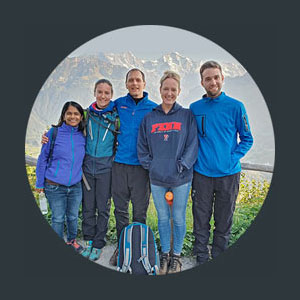Research tweets.
Text: Anika Zielenski
Communicating with the community and finding out what other research groups are doing: Six scientists' experiences in their Twitterverse.
@christine_blume
Christine Blume @christine_blume discovered Twitter during the coronavirus pandemic. During that time, there were only a few conferences left for networking with other researchers. The feeling of a “research-community” on Twitter was therefore especially important for the chronobiologist.
For her, social media is all about being social. She uses these platforms primarily to connect with other researchers, to engage in discussions and simply to “see what research the others are doing”.
@CorneliusRoemer
Despite his large following on Twitter, Cornelius Roemer @CorneliusRoemer does not aim to reach as many people as possible with his tweets. Instead, he mainly wants to address interesting topics.
The computational biologist sees Twitter as a very open, democratic forum. The platform has also proven to be very practical for connecting with other researchers: Römer found the job posting for his current position on Twitter.
@ImmunologyKing
Carolyn King @ImmunologyKing is very aware of her social media consumption. According to the stats on her phone, the immunologist spends an average of 14 minutes a day on Twitter. Her kids really opened her eyes to the dangers of social media and she is careful about spending too much time on it.
King and her team started their Twitter account two years ago after a colleague recommended it. They have since found it to be a great tool to keep track of “the ever expanding universe of science”.
@braun_binder
Nadja Braun Binder @braun_binder is active on Twitter and LinkedIn. The legal scholar uses these platforms for both information and inspiration: “social media gives me food for thought”.
Through the posts, she finds references and studies, not unlike the way people used to come across interesting rulings while browsing through court decisions in the library. Her hope for the future is that social media could provide more open access to original sources, judgments and repositories.
@MartinRoosli
Environmental epidemiologist Martin Röösli @MartinRoosli invests his daily train commute in his Twitter account. The interest from and exchange with the public is particularly high in his field of expertise, mobile communications research.
But the general public can also sometimes be critical of Röösli’s research and he has had to respond to one or two unfriendly tweets. His advice for such situations: "Always stick to the facts!"
@jonathan_deroo
In order to cut down on the time he spends on Twitter, Jonathan de Roo @jonathan_deroo uninstalled the app on his phone and now only uses the desktop version. “It’s a more conscious choice,” he explains. The chemist used to be much more active on social media. While he still posts regularly, he tries to keep scrolling-time to a minimum.
De Roo usually tweets to promote his research or to celebrate his colleagues’ achievements. His research group even has their own Twitter account where they try to give potential new candidates an insight into what working in their team is like.






